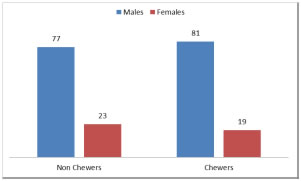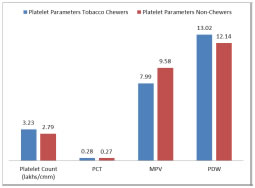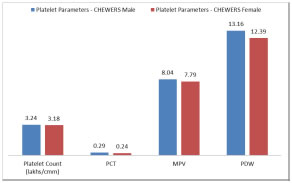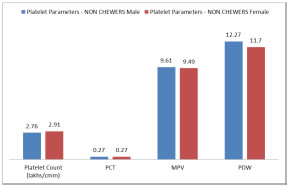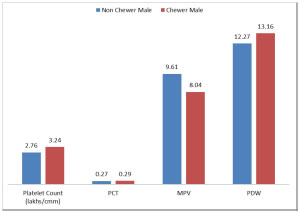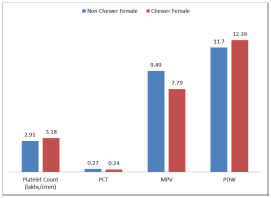Official Journals By StatPerson Publication
|
Table of Content - Volume 5 Issue 2 - February 2018
Effect of nicotine on platelet function
Fariha Mohammedi, Mohammed Abdul Hannan Hazari, Farisa Khatoon*, Kazi Husna Syed Imran Ali
Department of Physiology, DCMS, Telangana, Hyderabad, INDIA. Email: drfariha@hotmail.com
Abstract Background: Tobacco is the dried and processed leaves of the plant Nicotiana tobacum that is widely cultivated and commercially grown in many countries of the world. In India, tobacco is taken in several other forms also, for example, Pan (betel quid), dried leaves (Patti), paste (Qiwam, Zarda), tobacco with lime (Khaini/Mawa). Its use is common in various parts of the world, including India and central Asia. An increase in the consumption of tobacco has been noticed among high school students, college students, and sportspersons .This is immensely popular in all socio economic states in India. It is viewed as especially ominous because of the ease , low expense of procurement, youth appeal, convenient shelf life and lack of social stigma. Despite the known health consequences of tobacco chewing‖ is not viewed by users as particularly dangerous and is considered less of a ―social evil‖ than smoking by much of the public. Previous reports have described long-term harmful effects of nicotine on various body parameters.. In view of the various pharmacological actions of nicotine and additives and the wide use in many regions and countries, chronic consumption may affect the status of hematological parameters and further delineate the effects of tobacco use to health. The effect of smokeless tobacco use on health irrespective of the mode of consumption has been well documented. Objective: this study was conducted to determine hematological effects of nicotine on platelet count and its functions. Materials and Methods: This cross sectional study was done in the department of internal medicine Owaisi Hospital and Research Centre. A detailed assessment was done on 200 apparently healthy subjects, out of which 100 were tobacco chewers and 100 non chewers. Various parameters were recorded which include personal details, department of work, history of smoking , chewing tobacco, history of exposure to tobacco smoke, history of any chronic disease like diabetes mellitus and medication history. Hematological investigations done. Automated blood analyzer was used for estimation of platelet count Results: In tobacco chewers the following platelet parameters are higher than non-chewers. 1. Platelet count -Statistically significant. 2. PCT- not significant statistically. Key Words: Nicotine, Platelets, tobacco.
Tobacco is the dried and processed leaves of the plant Nicotianatobacum that is widely cultivated and commercially grown in many countries of the world. It is mostly consumed in the forms of smoking, chewing, snuffing, or dipping tobacco. People in many regions and countries, including North America, northern Europe, India and other Asian countries, and parts of Africa, have a long history of using smokeless tobacco products. It is either inhaled through the nose or applied orally. Some addicts also chew the dried leaves In view of the various pharmacological actions of nicotine and additives and the wide use in many regions and countries, chronic consumption of Smokeless tobacco may affect the status of hematological parameters and further delineate the effects of tobacco use to health. The effect of smokeless tobacco use on health irrespective of the mode of consumption has been well documented. In users of smokeless tobacco , nicotine is absorbed through the mouth where it goes to the brain. Even after removal of tobacco from the mouth, nicotine continues to be absorbed into the bloodstream. In addition, nicotine stays longer in the blood for users of smokeless tobacco than for smokers. The risks associated with smokeless tobacco use include cancer (particularly oral, esophageal and pancreatic cancers), heart disease, gum disease and oral lesions other than cancer.The frequency and speed of tobacco consumption and the effects which it has on the body is directly related to nicotine, the most prominent phytochemical found in tobacco. All tobacco products, including smokeless tobacco, contain nicotine, which is highly addictive. A Center for Disease Control and Prevention study of the 40 most widely used popular brands of moist snuff showed that the amount of nicotine per gram of tobacco ranged from 4.4 to 25 milligrams. Other studies have shown that moist snuff had between 4.7 and 24.3 milligrams, dry snuff had between 10.5 and 24.8 milligrams, and chewing tobacco had between 3.4 and 39.7 milligrams per gram of tobacco. Users of smokeless tobacco and users of cigarettes have comparable levels of nicotine in the blood. MATERIALS AND METHODS Sample size: Study included 200 apparently healthy subjects out of which 100 were tobacco chewers and 100 non tobacco chewers. Source of data: The study includes subjects from the Internal Medicine and Dental Outpatient department of Owaisi Hospital and Research Centre and Princess Esra Hospital, both of which are affiliated to Deccan College of Medical Sciences, Hyderabad Subjects aged 18-50 years, of both the sex were taken for the present study. Age and gender matched, healthy subjects, who don‘t smoke tobacco were taken for the present study.
Documentation of detailed history of present and past illness, personal history of all the participants in the present study was done.
Vacuum evacuated tubes.
Platelet count, platecrit PCT, Mean platelet volume, MPV, Platelet distribution width PDW were calculated. The data collected were analyzed and expressed as Mean + SD.
Microsoft Word and Excel to generate graphs and tables.
while analyzing the data.
OBSERVATION AND RESULTS Table 1: Gender wise distribution of subject
Figure 1: The number of males is significantly higher both in chewer and non-chewer subject difference in platelet parameters Table 2: Platelet Parameters
Figure 2: Difference in platelet parameters In tobacco chewers the following platelet parameters are higher than non-chewers.
Table 3: Platelet parameters tobacco chewers
Figure 3: Platelet parameters-chewers Above table shows that all platelet parameters are more in male chewers than Female chewers, but the difference is statistically not significant.
Table 4: Platelet count among non tobacco chewers
Figure 4: Platelet Parameters-NON CHEWERS Platelet parameters are not having any statistically significant difference in male and female non chewers Table 5: Platelet Parameters - NON CHEWERS vs CHEWERS MALES
Platelet count in males is significantly more and MPV is significantly low in chewers than non-chewers.
Figure 5: Table 6: Platelet Parameters - NON CHEWERS vs CHEWERS FEMALES
Figure 6: MPV is significantly less in female chewers than female non-chewers. Other parameters are not different significantly.
DISCUSSION The status of hematological parameters, are useful physiological markers of organ and tissue damage and dysfunction. In view of the various pharmacological actions of nicotine and additives and the wide use in many regions and countries, chronic consumption of tobacco may affect the status of hematological parameters. further delineate the effects of tobacco use to health. In the present study we investigated the effect of of tobacco on hematological parameters such as platelet counts, platelet parameters. chewing tobacco non-users and users were 100 subjects each in group. In the present study, difference in all parameters between chewers and non chewers is statistically highly significant. The result was a significant decrease in platelet count. This is in agreement with the present study where there is a significant decrease in platelet count. In the present study the effect of tobacco on platelets is also studied. The results were as follows: In tobacco chewers the following platelet parameters are higher than non-chewers.
PCT were observed significantly low in tobacco chewers than non chewers (P=0.017). Low PCT value indicates the platelet abnormality resulted by absence of a bone marrow response to a peripheral demand for platelets. It did not find any significant changes in platelets (PLT), mean platelet volume (MPV) or platelet distribution width (PDW) between tobacco chewers and nonchewers. This is in contrast with the present study where PCT is not reduced significantly. The previous reports have shown that chronic use of nicotine causes platelet activation and use of tobacco cessation improves platelet function. This is in agreement with the present study where, there is gross difference in all parameters between chewers and non-chewers and is statistically very significant.
CONCLUSION Platelet parameters in tobacco chewers were compared gender wise. The results showed that all platelet parameters are increased in male chewers than female chewers. But the difference is not statistically significant Platelet parameters were compared in non-tobacco chewer‘s gender wise. The platelet parameters did not show any statistically significant difference in male and female non chewers. Platelet parameters were compared in male non tobacco chewers and male tobacco chewers. The results showed platelet count in chewer males is high and MPV is significantly less in chewers. Platelet parameters between female non chewers and female chewers were compared. The result showed MPV is significantly low in female chewers. Other parameters are not affected significantly.
REFERENCES
|
|
 Home
Home
